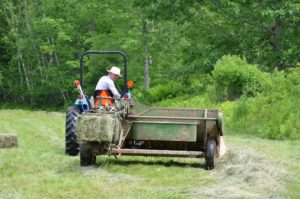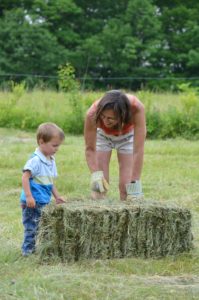Note: This post appeared in the old PlaceWorks blog a few years ago. Haven’t made hay here on the farm for a while – but back in the day, per this post, it was a whole family operation.
June 10, 2010 Made first hay of the season over the past few days. Mostly an exercise in revivifying old machinery (I do think of my ancient baler as having a life of its own), but also a  chance to reconnect with field, sun, and sky. As I mentioned in an earlier post on making maple syrup, these home place seasonal tasks are part practical, part spiritual – essential aspects of the life experience here.
chance to reconnect with field, sun, and sky. As I mentioned in an earlier post on making maple syrup, these home place seasonal tasks are part practical, part spiritual – essential aspects of the life experience here.
Anyone who has ever put up hay will tell you it takes some preparedness, a fair amount of hard work, and, when the time comes, quite a lot of luck to succeed at the enterprise. Weather is the primary variable, but machinery and crew represent two more. This year, a dry May has given way to a somewhat wetter June. Last summer when we hit that turn, it was six weeks before we came out of it; I couldn’t get on to my fields until mid July, and even then tractor tires glistened from standing water in many places. Truth is, before we could get started, the hay had “gone by” and was hardly worth picking up – though the cows would have to eat something once winter snows began to fly, so we went on with it anyway.
In spring, when grasses ripen (different weeks for different varieties), the first step in hay making is to mow. Mowing has its own pace (slow) and allows time for reflection. When the day is warm, the wind gentle, and the old sickle bar is functioning properly, the experience is heavenly. A special treat when the barn swallows swoop in after the insects that the mower kicks up.
A mowing day is followed by a day of rest for the farmer while the sun does its work, pulling moisture from leaves and stems, sweetening the hay to taste and smell. If the sun isn’t working hard enough, though, the farmer must compensate, fluffing the hay with a tedding machine, or in my case a pitchfork, working it dry. Finally, on day three, we are ready to rake and bale. Raking again brings out the birds and is usually rather carefree. The rake gathers and furls the hay into windrows, long graceful lines that give the field a whole new look and feel. Windrows position the hay for maximum final drying, and after an hour or two, the hay is ready to bale. Ah, baling – yes, there’s the rub.
My baler is a most remarkable contraption, with arms and wheels, chains and levers, all linked together to create a fabulous system which, as it moves through a field, whirls and bangs away, groaning at times when the intake is too voluminous or tough. Windrows are gathered into the front of the machine, then the hay is chopped, compressed, and driven through a square shoot (my baler makes square bales). As the bale reaches the appropriate weight and length, the machine, sensing the time is right, drives needles holding twine through the hay and into a complex mechanism that ties knots to secure the bale, which is then (rather unceremoniously) pushed out onto the field. It is as if the baler were giving birth to the bale – but nobody is “oohing” or “ahing,” except for the proud father, of course. That the thing ever worked to begin with is amazing. That it continues to work after at least fifty seasons of heavy use (only about twenty under my stewardship) is miraculous.
OK. Enough about machinery, and back to weather. When the baler is working (which, to be fair, is most of the time), we are at the next to last step in the hay making process, the final step  being the trip to the barn. And by this next to last step, we have already enjoyed two and a half days of dry weather, and it seems, almost without fail, that, at this very moment, middle of the last step in the process, with little forewarning (nothing about these guys in the forecast last night!), the big thunder boomers start to take shape in the western sky. (Here in our part of Maine weather tends to travel west to east.) The machine is working, but where is the crew? Slowly but surely, they arrive – first wife Wendy, then neighbor kids, and after that a friend from across town who saw the clouds rising, and (oh-my-gosh) a visiting couple from New York we haven’t seen for years but who thought they would stop by this particular afternoon on their way to Bar Harbor – there they all are, following the wagon around the field, pitching bales with the best of ’em, just as if they had been pitching hay their whole lives long! And when the last bale goes in the barn, and the first rain drops begin to fall – we all stand around laughing and joking – and sharing an experience that people have been having in this place for at least a hundred years. And all of us now knowing this place a little more deeply than we did before.
being the trip to the barn. And by this next to last step, we have already enjoyed two and a half days of dry weather, and it seems, almost without fail, that, at this very moment, middle of the last step in the process, with little forewarning (nothing about these guys in the forecast last night!), the big thunder boomers start to take shape in the western sky. (Here in our part of Maine weather tends to travel west to east.) The machine is working, but where is the crew? Slowly but surely, they arrive – first wife Wendy, then neighbor kids, and after that a friend from across town who saw the clouds rising, and (oh-my-gosh) a visiting couple from New York we haven’t seen for years but who thought they would stop by this particular afternoon on their way to Bar Harbor – there they all are, following the wagon around the field, pitching bales with the best of ’em, just as if they had been pitching hay their whole lives long! And when the last bale goes in the barn, and the first rain drops begin to fall – we all stand around laughing and joking – and sharing an experience that people have been having in this place for at least a hundred years. And all of us now knowing this place a little more deeply than we did before.
Just was thinking of friend Josie Merck who a few years back created some wonderful paintings on the haying theme. Went online to find an illustration and came upon this short film she made on the subject. Title of the film – “The Birth of a Bale.” Lot’s of great vintage shots, many from Maine. Thanks Josie. http://www.youtube.com/watch?v=5FAcwXD9vGs